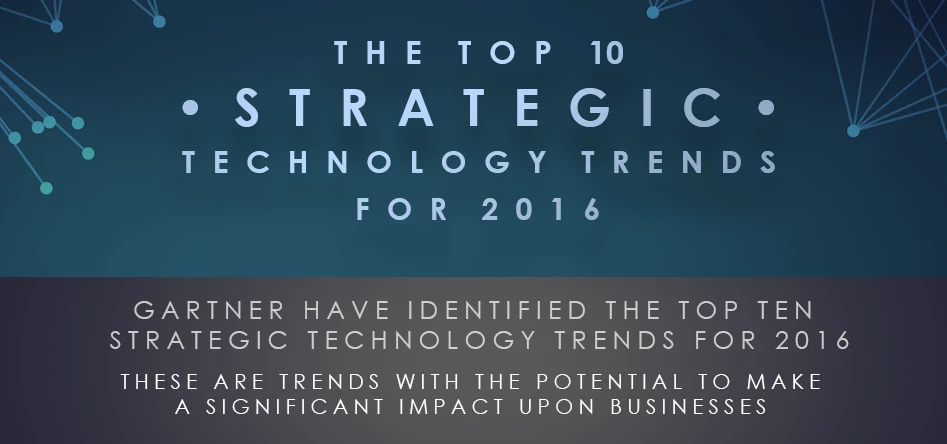
Infographic: The top ten Tech Trends of 2016
There is no doubt that the rapid development of technology in the course of a relatively short amount of time has brought incredible changes to the lives of people all over the world. This level of innovation shows no signs of stopping any time soon, which is exactly why it is so important to forecast for the future.
An infographic created by Lucas Blake outlines the top 10 strategic technology trends for 2016 as identified by Gartner. Strategic trends are those with the potential to make a significant impact upon businesses, meaning any business with an understanding of these trends could be at a significant advantage for the future.
The device mesh is the first identified trend. This involves the interconnected mesh of devices that will form as connection models evolve and an increased level of interaction occurs between devices. It will remove the limitations of current isolated devices, offering an expanded set of endpoints for people to use. This will also lead to the development of ambient user experience, the second trend. The opportunity for a continuous fluid user experience presented by the device mesh is something that will result in technology that removes boundaries and bridges both space and time.
Another trend that relates to human engagement with the real world is 3D printing. This technology is expected to keep growing for the next 20 years, and while the technology itself has already developed in a number of ways, the increased amount of materials that can be printed is expected to be a major trend for the future as more substances are used. This will lead to a shift in the way that people understand the supply chain. Equally, the understanding of many businesses will be altered thanks to the information of everything.
This trend relates to the idea that so many new sources of data will be available in the near future, with information growing further year on year. This rise in data will lead to additional opportunity to analyse it using new semantic technologies.
Advanced machine learning, the fifth trend, relates closely to this new mass of data as well. Higher amounts of data combined with deep neural nets will result in intelligent machines that can autonomously learn to perceive the world. This could lead to major improvements in business efficiency, especially for businesses that take advantage of the sixth trend, autonomous agents and things. Because of machine learning there will be far more opportunity for autonomous technologies to emerge including robots, virtual personal assistants, and autonomous vehicles. This new technology will augment human activity and liberate people from many menial tasks.
The growth of technology will also mean that there is a growth in technological threats. Security has been a pressing issue for some time already, and as technology develops further security will need to develop as well. This relates to the seventh trend, adaptive security architecture. This security architecture will be adaptable and will lead to digital items that are inter-connected while still being independently secured.
The development of security architectures will coincide with the eighth trend, advanced system architecture. System architectures will need to change substantially in order to accommodate the changes that are approaching in the future. The use of ultra-efficient neuromorphic architectures will mean machines operate more like humans and will enable quick computing to support future technology.
The ninth trend connects with many of the other trends as it will be important to the growth of the digital mesh and the fluid systems that are both intelligent and intuitive, creating an ambient digital world. Mesh app and service architecture is a trend that indicates how application design will need to become more agile and scalable rather than being rigid and monolithic, resulting in minimal output for required functionality.
The same lessons must also be learnt for platforms for the internet of things which will need to be developed to support the digital mesh and ambient user experience, constituting the tenth trend. The internet of things is vital to the direction future technology is moving in, as such platforms must be created that can support the information on offer.
These strategic technology trends for 2016 have far reaching consequences as, in many ways, they connect with ideas for the future. However, the future appears to be approaching faster than ever, and this means that people should take the opportunity to incorporate this information into their plans as soon as possible in order to benefit from the advancements that are being made. The increased integration of technology into everyday life is unlikely to stop any time soon, meaning it is far better to embrace it and acknowledge the trends that exist.
This was posted in Bdaily's Members' News section by Kat Kynes .








 How to make your growth strategy deliver in 2026
How to make your growth strategy deliver in 2026
 Powering a new wave of regional screen indies
Powering a new wave of regional screen indies
 A new year and a new outlook for property scene
A new year and a new outlook for property scene
 Zero per cent - but maximum brand exposure
Zero per cent - but maximum brand exposure
 We don’t talk about money stress enough
We don’t talk about money stress enough
 A year of resilience, growth and collaboration
A year of resilience, growth and collaboration
 Apprenticeships: Lower standards risk safety
Apprenticeships: Lower standards risk safety
 Keeping it reel: Creating video in an authenticity era
Keeping it reel: Creating video in an authenticity era
 Budget: Creating a more vibrant market economy
Budget: Creating a more vibrant market economy
 Celebrating excellence and community support
Celebrating excellence and community support
 The value of nurturing homegrown innovation
The value of nurturing homegrown innovation
 A dynamic, fair and innovative economy
A dynamic, fair and innovative economy